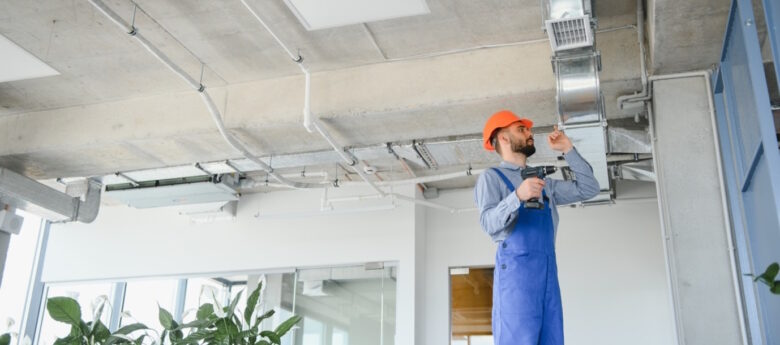Building Materials Matter: Strategies for Improved IAQ

Indoor air quality (IAQ) has recently become a pressing priority as studies indicate that indoor air can be 2-5 times more polluted than outdoor air and that indoor air pollution is one of the top 5 environmental risks to public health. We now spend up to 90% of our time indoors, much of it in office buildings or educational facilities. These stark statistics make it very clear that for professionals and decision-makers in facility management, understanding and improving IAQ is vital for ensuring the health, comfort, and productivity of building occupants.
The Health Impacts of Poor Indoor Air Quality
Exposure to indoor pollutants can lead to a range of health complications, from respiratory issues to chronic diseases such as cancer and cardiovascular conditions. Volatile Organic Compounds (VOCs) can be particularly harmful. Immediate effects of VOC exposure include eye, nose, and throat irritation, headaches, dizziness, and fatigue, while long-term exposure has been linked to the development of respiratory diseases, cardiovascular problems, and cancer.
Mold spores and allergens can exacerbate respiratory issues and conditions such as asthma and allergies. Additionally, dust and other particulates contribute to poor indoor air quality, and infectious aerosols can spread diseases, as highlighted during the COVID-19 pandemic.
Studies have shown that IAQ significantly impacts cognitive function. Occupants in buildings with low VOC levels scored 61% higher on critical thinking skills tests compared to those in buildings with average VOC levels. Furthermore, cognitive test scores are 26.4% higher in high-performing, green-certified buildings, underscoring the critical role of air quality in both health and productivity.
The Role of Building Materials in IAQ
Historically, building materials have caused significant health problems – wallpaper with arsenic-based pigments, lead in paint products, and asbestos in roofing and insulation are just some examples from the past.
Today, building materials (such as paint, insulation, and flooring), cleaning products, electronics, and furniture are potential sources of VOC emissions. Flooring can harbor dust mite allergens and pet dander. Insulation can also be a serious source of mold spores.
Poor ventilation systems exacerbate these issues by allowing pollutants to accumulate and can also be responsible for the spread of infectious aerosols.
Evolving Regulations and Standards
While regulations around building materials are evolving, they often fall short of comprehensive protection. ASHRAE recently introduced ASHRAE 241 – a pioneering standard aimed at controlling aerosols in existing buildings and major renovations. This standard marks a milestone by offering guidance on operating buildings to prevent the transmission of infectious particles. It also stresses the significance of air purification technologies and promotes the adoption of verified and approved solutions.
With time, we can expect further standards and recommendations around healthier buildings. However, for the moment, there remains a significant voluntary responsibility on facility decision-makers to select materials and systems that support better IAQ.

Overcoming the Challenges of “Selfie Seals”
With rapid changes in consumer demand, and possibly due to financial constraints on manufacturers, the emergence of “selfie seals” – logos or symbols resembling third-party certifications but that are just marketing tools – has posed a challenge. Facility managers must exercise caution by seeking trusted third-party certifications to ensure that the products they choose genuinely enhance air quality.
Prominent and widely recognized building certifications include LEED Certification, a leading green building rating system developed by the U.S. Green Building Council (USGBC), and the WELL Building Standard (WELL), which provides a framework for designing and certifying spaces that promote human health and well-being. To achieve these certifications, the selection of building materials must be a deliberate and thoughtful process. Opting for materials that have been independently tested and certified, can significantly streamline this process.
For facilities managers, having a thorough understanding of the various certifications is crucial. As consumers become more educated about the health impact of their indoor environment, there is a growing demand for healthier buildings. Facilities management professionals are responsible for meeting this demand by leveraging their expertise in selecting building materials that positively influence indoor air quality. By incorporating certified and validated materials, facilities managers can provide healthier environments for occupants.
Strategies & Optimal Approaches for Enhanced Indoor Air Quality
Facilities managers can adopt several best practices to maintain and improve indoor air quality (IAQ). They should ensure proper ventilation by utilizing trusted mechanical ventilation systems to provide fresh air, exhaust contaminated air, and ensure regular maintenance of these systems. Additionally, choosing HVAC systems tested to effectively reduce allergens of different sizes, even when loaded with dust, is important.
To reduce VOCs, managers should opt for paints, sealants, insulation, and flooring labelled as low-VOC or zero-VOC and seek out certified products from reputable organizations that meet stringent emission standards. Installing tested and validated air purifiers will help capture particulate matter and other pollutants. Implementing cleaning programs that use products tested and validated to contain minimal harmful chemicals is also crucial.
Finally, educating occupants about the importance of IAQ and encouraging practices that support a healthy indoor environment will help maintain optimal air quality.
Indoor air quality is a critical factor influencing the health and productivity of building occupants. For facilities management professionals, the implementation of best practices is essential to ensuring healthier indoor environments. By staying informed about evolving regulations, avoiding deceptive “selfie seals,” and prioritizing certified products, facilities managers can lead the way in creating spaces that promote well-being.
The growing need for healthier indoor environments puts facilities managers at the forefront of a trend towards a future where ensuring clean indoor air is mainstreamed in facilities management. By recognizing the profound impact of IAQ and taking proactive steps, facilities management professionals can greatly improve the well-being of individuals who occupy indoor spaces.
Dr. Anna O’Donovan is a qualified doctor who worked in both hospital medicine and as a General Practitioner for a number of years. Anna studied medicine in Trinity College, Dublin, Ireland graduating with an honors degree in Medicine in 1997. Anna is also a qualified Dentist graduating with an honors degree and won the prize in oral medicine, oral surgery and oral pathology.
The post Building Materials Matter: Strategies for Improved IAQ appeared first on Facility Management.

